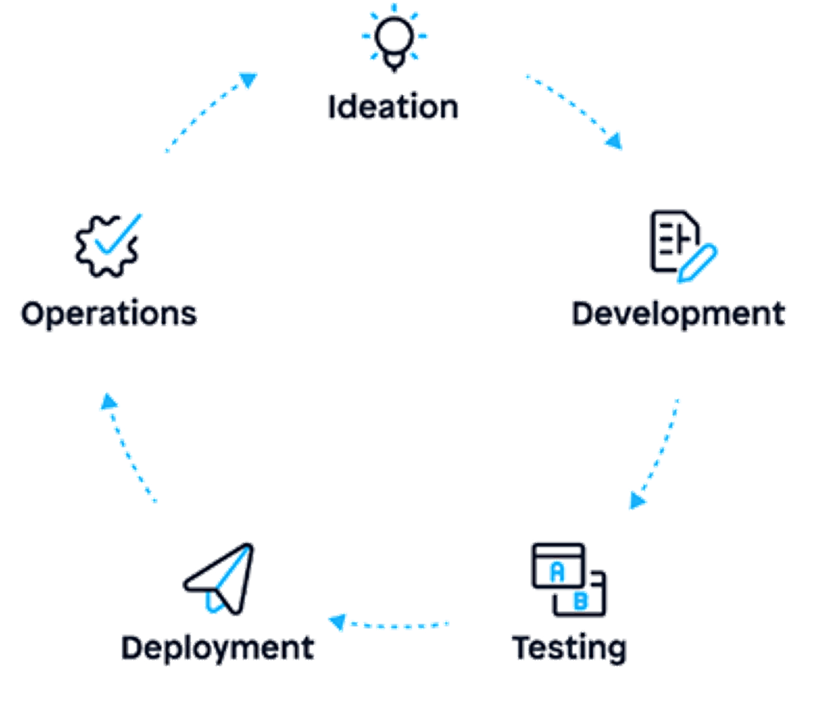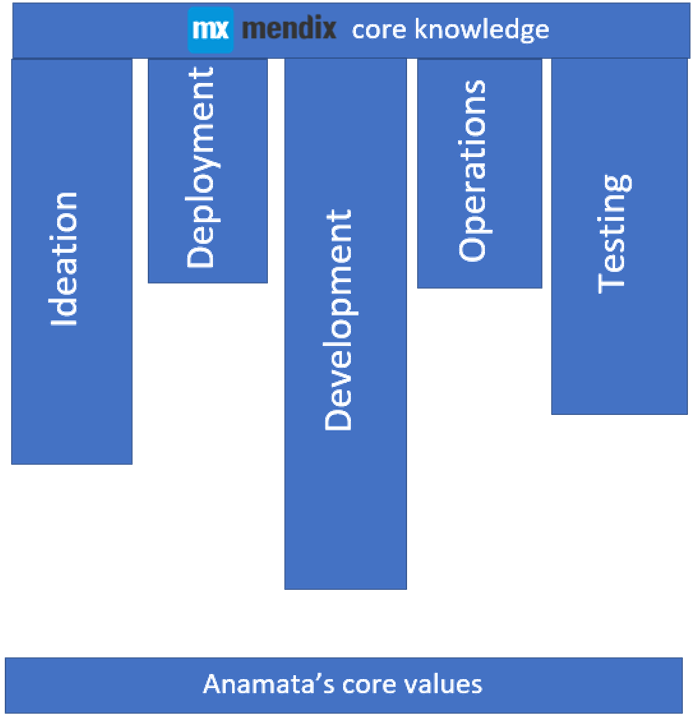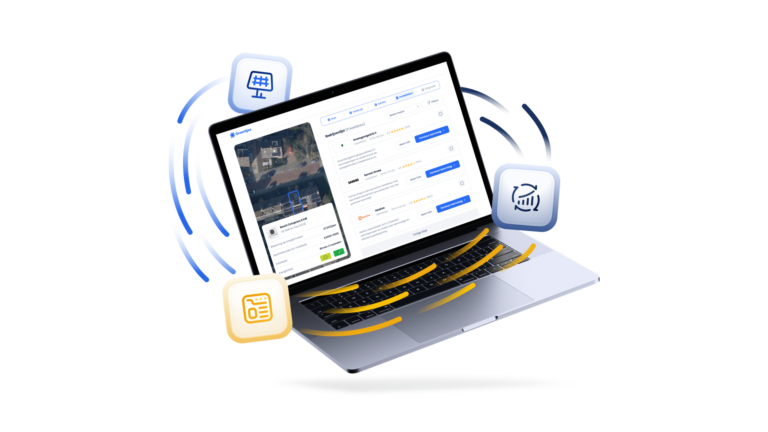Deliver 6 times faster with Mendix
“Mendix’s rapid application development tools empower both developers and business users to build mobile and web apps 6 times faster and more flexibly than with traditional methods of development.”1 , Mendix says. Also, the speed and ease of developing Mendix applications has improved a lot in the last years. For example, every new product release contains solutions and functionalities to make the app creation faster and/or more flexible. However, using the Mendix application development lifecycle you might easily go fast, but you can easily go fast in the wrong direction. On top of that, ‘building apps’ 6 times faster will not result in a 6 times faster delivery. That is only possible when all disciplines in the Mendix application development lifecycle are 6 times faster.
Therefore, the Mendix application development lifecycle doesn’t always result in a first-time-right deployment. Furthermore, with the reduction of the time spent on actual building on a low-code platform, mastery of the other disciplines becomes increasingly important to guarantee fast delivery of useful features.
M-Shaped
Anamata believes that every member of a delivery team should not only know the desired business outcomes, but also the elements comprising Mendix application development lifecycle. Team members do not have to be an expert in everything, but they should at least have a basic knowledge of all the aspects involved, while keeping focus on their strengths. The project team as a whole is responsible for planning, development, testing, deployment, monitoring, operations. In other words; multidisciplinary is a must. Anamata calls this an M-shaped profile. You can read more about this in our previous story.

But how does Anamata project this M-shaped profile on their Mendix consultants?
Mendix Application Development Lifecycle
First, I wanted to understand how the ideal Mendix application development lifecycle should look like.
I found two Mendix web pages, both referring to a different application lifecycle. The first hit gave me the ‘App lifecycle’ 3, using the following stages: Requirements, Developing in Mendix, DevOps, Deployment. The second hit gave me the ‘Mendix Application Development Lifecycle’4, defining the following stages: Ideation, Development, Testing, Deployment, Operations. The headline is screaming “Behind every great app is a clearly defined process”. But, well… apparently, Mendix doesn’t have a ‘clearly defined process’ themselves. But that is a discussion for later 🙂
Let’s assume that the Mendix lifecycle is the same as they use in their Mendix Expert requirements list.

Since low-code is focused on short cyclic value delivery, these stages are very entangled. For Anamata, these are not stages. These are disciplines needed in a DevOps team for successful delivery. For example, as testing is done throughout all stages of a project, it is not a separate stage. It is a separate discipline within the team. So we will remove the arrows and speak of disciplines rather than stages.
Regarding the entanglement of these disciplines, team members with extended knowledge in multiple disciplines are of great value, and increase the chance of success for the project. This is why Anamata’s M-model is focused on, but not limited to, this Mendix application development lifecycle. Our Mendix Consultants should have – or gain – basic knowledge of all disciplines of the Mendix application development lifecycle. In addition, the Anamateer should have (or develop) Mendix Advanced Developer skills and broaden their knowledge by exploring at least two of the other aspects.
Before explaining the M-profile, I want to explain a bit more about how the Mendix application development lifecycle per discipline.
Ideation
“In the first stage, teams define the purpose and goals of the new app, evaluate user expectations, and build a shared understanding of all requirements. Additional tasks include gathering requirements, estimating costs, and allocating resources.”
I will start explaining the Mendix application development lifecycle with the discipline ‘Ideation’. For instance, Mendix’ developer portal (SprintR) is offered by Mendix as the place for collaboration as a team. This platform can be used for backlog management, user feedback management and deploying and monitoring your applications. Also, Mendix Studio can be used by citizen developers to create applications without knowing anything about coding in Mendix Studio Pro. So, knowing how agile software development works for Mendix projects and how to quickly capture requirements in an application should be the basics for our consultants. In addition, the ‘Ideation’ vertical can be extended with knowledge of/experience in requirements engineering, design thinking, Scrum, etc. This can be achieved with challenging projects with a combination of Mendix development and Scrum Master for example, knowledge sharing and by following courses and exams (PSM, IREB).
| Discipline | Basic knowledge | Extended knowledge | How? |
| Ideation | Knowing how agile software development works for Mendix projects | Requirements engineering, Design thinking, Scrum, project experience | Challenging projects, following courses and exams (PSM, IREB), knowledge sharing |
With Mendix development you might easily go fast, but you can easily go fast in the wrong direction.
Development
“As soon as requirements are gathered and plans are in place, app development can begin.”
This second discipline of the Mendix application development lifecycle is the core of the Mendix consultant; building an application. Whether you build with Mendix Studio or Mendix Studio Pro, continuous collaboration between business and IT developers is ensured. Our consultants need to have at least their rapid developer certificate as their base development knowledge. In addition, the Development vertical can be extended with knowlegde of/experience in Mendix development, high code (Java, Javascript), UI/UX, integrations, etc. This can be achieved with challenging projects to extend the Mendix core and high-code knowledge, knowledge sharing and by following specific courses and exams (java, intermediate/ advanced/ expert).
| Discipline | Basic knowledge | Extended knowledge | How? |
| Development | Having your rapid developer certificate | Mendix development experience, high code, UI/UX, integrations, project experience | Challenging projects, following courses and exams, knowledge sharing |
Testing
“This phase involves quality assurance and testing procedures to ensure that the app performs as needed by the business and as expected by users.”
This discipline is focused on testing and quality assurance throughout the project. From requirements engineering to operations. Therefore, our minimum requirement is to be critically minded and to love delivering quality. In addition, you can extend your Testing vertical with knowledge of/experience in Mendix Unit Testing (MTA), AQM, ATS, JUnit, Selenium, qualitative/maintainable development, etc. You can achieve this with challenging projects, knowledge sharing and following specific courses and exams.
| Discipline | Basic knowledge | Extended knowledge | How? |
| Testing | Critically minded and the love and urge to deliver quality. | Exploratory testing, risk analysis, Test tooling (e.g. Mendix Unit Testing (MTA), AQM, ATS, Selenium), qualitative/ maintainable development, ISTQB, project experience | Challenging projects, following courses and exams (Intermediate/ advanced/expert dev), knowledge sharing |
Deployment
“Now it’s time to make your app available to end users. Low-code helps you ship solutions faster to your users while simplifying cloud operations, and Mendix makes it easy to deploy cloud-native apps on the cloud of your choice..”
The fourth discipline of the Mendix application development lifecycle is ‘Deployment’. Using the Mendix’ developer portal, for instance, it is very easy to deploy specific versions to specific cloud environments. So, knowing what cloud services and deployments are and how to use this via the Mendix developer portal, should be the basics for every consultant. In addition, you can extend your Deployment vertical with knowledge of/experience in Continuos Integration/Delivery (CI/CD), Azure, containers, Kubernetes, application management, etc. You can achieve this with challenging projects, knowledge sharing and following specific courses and exams.
| Discipline | Basic knowledge | Extended knowledge | How? |
| Deployment | Knowing what cloud services and deployments are and how to use this via the Mendix developer portal | CI/CD, Azure, containers, Kubernetes, application management, project experience | Challenging projects, following courses and exams |
Operations
“Once the app is released to the masses, the nurturing begins. The final phase of the application development lifecycle focuses on continuous monitoring and maintenance for long-term app health and usability.”
Finally, the fifth discipline Mendix provides in their Mendix application development lifecycle is ‘Operations’. Also App maintenance is integrated in the Mendix developer platform. Logging, performance metrics and other build-in monitoring tools. Integrations with parties as AppDynamics to monitor the app are also available. So, where to find, and how to use, these build-in monitoring tools are the basics for our consultants. In addition, you are able to extend your Operations vertical with knowlegde of/experience in external tooling (like AppDynamics), setting up monitoring dashboards, SAP platform, etc. You can achieve this with challenging projects, knowledge sharing and following specific courses and exams.
| Discipline | Basic knowledge | Extended knowledge | How? |
| Operations | Where to find, and how to use, these build-in monitoring tools | External tooling (like AppDynamics), setting up monitoring dashboards, SAP platform, project experience | Challenging projects, following courses and exams |
The project team as a whole is responsible for planning, development, testing, deployment, monitoring, operations. In other words; multidisciplinary is a must.
M-Shaped Mendix Profile
Now that I have explained each discipline of the Mendix application development lifecycle, he M-shaped profiles can be created. Here’s a summary of all the disciplines needed to set-up your own M-shaped profile.
| Discipline | Basic knowledge | Extended knowledge | How? |
| Ideation | Knowing how agile software development works for Mendix projects | Requirements engineering, Design thinking, Scrum, project experience | Challenging projects, following courses and exams (PSM, IREB), knowledge sharing |
| Development | Having your rapid developer certificate | Mendix development experience, high code, UI/UX, integrations, project experience | Challenging projects, following courses and exams (Mx Advanced/ Java), knowledge sharing |
| Testing | Critically minded and loving to deliver quality. | Exploratory testing, risk analysis, Test tooling (e.g. Mendix Unit Testing (MTA), AQM, ATS, Selenium), qualitative/ maintainable development, ISTQB, project experience | Challenging projects, following courses and exams (TMAP), knowledge sharing |
| Deployment | Knowing what cloud services and deployments are and how to use this via the Mendix developer portal | CI/CD, Azure, containers, Kubernetes, application management, project experience | Challenging projects, following courses and exams |
| Operations | Where to find, and how to use, these build-in monitoring tools | External tooling (like AppDynamics), setting up monitoring dashboards, SAP platform, project experience | Challenging projects, following courses and exams |
Using these disciplines, you are now able to create your own M-shaped profile. As an example, I have created my own M-shaped profile:

Finally, an important supporting factor in the M-model, are the Anamata core values. The values reflect the Anamateer’s soft skills and personality, which we explain here. Anamata’s core values support the hard skills of the top part of the M-model. In conclusion, combining our core values and the discplines of the Mendix application development lifecycle will make you the perfect M-shaped Mendix consultant.
Get your boarding pass at Anamata
Anamata is always looking for new colleagues to hop on our plane. If you want to become an M-shaped consultant or if you want to broaden your knowledge to other Mendix application lifecycle disciplines, please contact us so we can help you with your journey. Maybe you are interested in developing other areas as well? In that case, Anamata provides the opportunity to learn more about Pega or business consultancy. Let’s have a drink today, so we can talk about tomorrow. Maybe this will result in a great journey for both of us. Get your boarding pass now!





